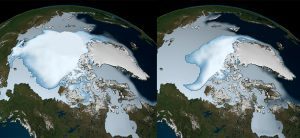
Arctic winter sea ice extent, with multi-year ice in bright white, in 1980 (left) and 2012. (Credit: NASA Sci. Vis. Studio)
Losing the remaining Arctic sea ice and its ability to reflect incoming solar energy back to space would be equivalent to adding one trillion tons of CO2 to the atmosphere, on top of the 2.4 trillion tons emitted since the Industrial Age, according to current and former researchers from Scripps Institution of Oceanography at the University of California San Diego.
At current rates, this roughly equates to 25 years of global CO2 emissions. It would consequently speed up the arrival of a global threshold of warming of 2ºC beyond temperatures the world experienced before the Industrial Revolution. Scientists and analysts, including the authors of an Intergovernmental Panel on Climate Change Special Report released in October 2018, have stated that the planet runs the risk of catastrophic damage ranging from more intense heat waves and coastal flooding to extinction of terrestrial species and threats to food supply if that threshold is passed.
The results were published June 20 in the journal Geophysical Research Letters. In “Radiative Heating of an Ice-Free Arctic Ocean,” former Scripps graduate student Kristina Pistone, now with the Bay Area Environmental Research Institute based at NASA Ames Research Center, and Scripps climate scientists Ian Eisenman and Veerabhadran Ramanathan, used direct satellite observations to assess the impact of a potential ice-free Arctic Ocean. The authors of the study conclude that the loss of sea ice will add a globally-averaged 0.7 watts per square meter (W/m2) of solar heating to the Earth system, 0.21 W/m2 of which has already occurred between 1979 and 2016.
